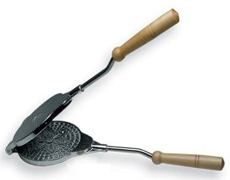Overview
The batter-based flat cake known as a waffle is a Belgian culinary specialty: Each region of the country has its own recipe. The basic ingredients are the same (flour, milk, eggs and a pinch of salt), but points of departure include yeast, caramelized sugar, leavenings and fillings or toppings. The recipes are handed over from one generation to the next, as covetously as a great cake recipe.
Yet the Belgian waffle culture probably originated in the Mediterranean, as a primitive flat cake cooked on a hot rock in a campfire. Let’s take a look at its evolution.
Waffle Timeline: In The Beginning
- Neolithic Age (ca. 6000 B.C.E. to ca. 2000 B.C.E.). As with bread, the ancestor of the waffle emerges in the Neolithic age as a rustic hotcake made of cereal pulps, cooked on heated stones. The cake is “flipped,” so that both sides can be cooked by the heat. There is no syrup, no whipped cream and no chocolate sauce yet—and likely, no salt and pepper.
- Iron Age (ca. 1200 to ca. 550 B.C.E.). The Iron Age brings iron tools, including the iron plate or griddle. Man can now make the equivalent of griddle cakes or pancakes. At some point, some cook uses two heated iron plates, one on each side of the pancake, to speed cooking.
- Ancient Greece (1100 B.C.E. to 146 B.C.E.). Ancient Greeks cook these flat cakes, called obleios or wafers, between two hot metal plates. They are primarily savory in nature, flavored with cheeses and herbs.
As Mankind Progresses
- Middle Ages (400 C.E. to 1000 C.E.). This method of cooking continues to be used in the Middle Ages by the obloyeurs. These specialists make different types of oublies, as the word has evolved from the Greek. They are served flat or rolled into filled coronets (cones).
- The irons are used to produce a variety of different flat, unleavened cakes (usually from a mixture of barley and oats, not the white flour used today). In many cities, waffles are sold off carts by street vendors. Judging from extant illustrations, customers get their money’s worth, as the waffles seem about the size of a small pizza.
|
- 13th Century. The oublie becomes the waffle in the 1200s, when a craftsman has the idea of forging some cooking plates or “irons” that reproduce the characteristic pattern of honeycombs. The word gaufre, from the Old French for waffle (wafla), first appears in print at this time. Wafla means “a piece of honeybee hive.” Other early waffle irons designs include landscapes, coats of arms and religious symbols. The batter is placed between hinged plates that are then pressed together with wooden handles, held over the hearth fire to bake and flipped manually.
|
|

While there are electric versions, this manual
modern pizzelle iron works like the original
waffle iron. The waffle can be baked over a
fireplace, but modern cooks might prefer
the stovetop. Find out more about the pizzelle iron. |
- The waffles are sold by street vendors. For religious celebrations or saints’ days, the vendors are allowed to sell their waffles at church door exits. Over the years, there are more and more vendors fighting over space and customers, until France’s King Charles IX (1560-1574) has to quell the disturbances by regulating the business: Vendors have to stay about six feet from each other.
- 16th Century. Waffles serve all echelons of society. They are made of water and bad flour and eaten by the poor during bread shortages. While waffles for the common people are thick, waffles for the privileged class add eggs, milk and honey to create delicate and tasty waffles.
1620. Dutch “wafles” come to America with the Pilgrims, who spend time in Holland prior to sailing to America.
1735. The word “waffle,” with two “fs,” appears in print in English for the first time.
- 1789. At the start of the French Revolution, Thomas Jefferson returns to the U.S. from his position as Minister to France. Along with a pasta machine, he brings a long-handled waffle iron that encloses the batter and gives the waffle crispness and shape. This begins the trend of “waffle frolics” or waffle parties, where guests can enjoy their waffles sweet (with maple syrup or molasses) or savory (topped with kidney stew). Slaves get the leftovers as a special treat. This evolves into the southern favorite, chicken and waffles.
- 1800s. Vendors on city streets sell hot waffles slathered with molasses or maple syrup.
- 1869. Cornelius Swarthout of Troy, New York, a Dutch-American, receives a patent for the first waffle iron in the U.S., on August 24th. Described as a “device to bake waffles,” one heats up the waffle iron over a coal stove, pour batter on the griddle, close the cover and after a few minutes, flip the griddle and cook the other side of the waffle. It becomes very popular. The anniversary of the patent is now celebrated as National Waffle Day.
Continue To Page 2: The Modern Waffle & Waffle Glossary
Go To The Article Index Above
|
